Assessing pH-Dependent Conformational Changes in the Fusion Peptide Proximal Region of the SARS-CoV-2 Spike Glycoprotein
Abstract
1. Introduction
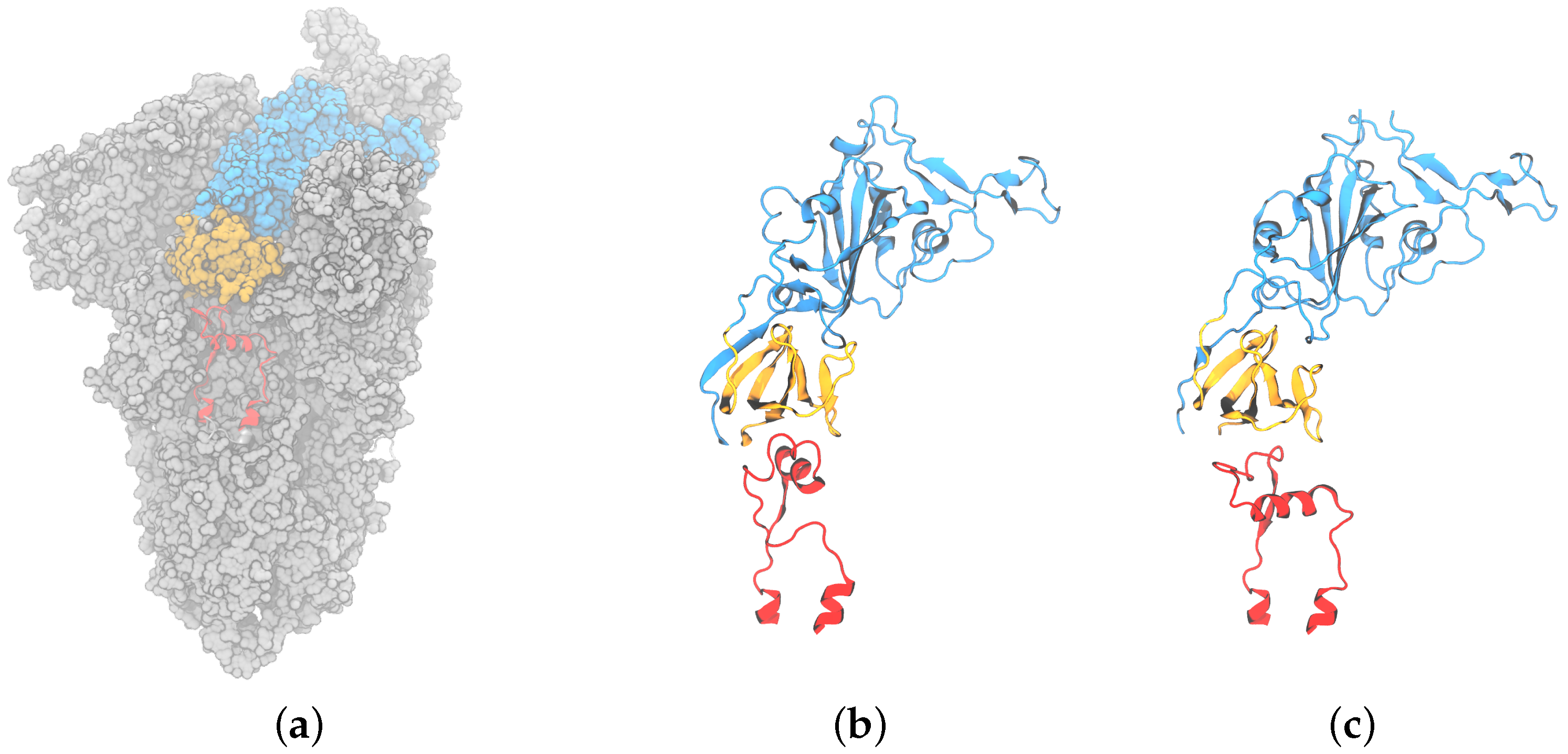
2. Materials and Methods
3. Results and Discussion
3.1. Experimental Structural Analysis
3.2. Constant-pH REMD Simulations
4. Conclusions
Supplementary Materials
Author Contributions
Funding
Data Availability Statement
Conflicts of Interest
References
- Lu, M.; Uchil, P.D.; Li, W.; Zheng, D.; Terry, D.S.; Gorman, J.; Shi, W.; Zhang, B.; Zhou, T.; Ding, S.; et al. Real-Time Conformational Dynamics of SARS-CoV-2 Spikes on Virus Particles. Cell Host Microbe 2020, 28, 880–891.e8. [Google Scholar] [CrossRef] [PubMed]
- Sztain, T.; Ahn, S.H.; Bogetti, A.T.; Casalino, L.; Goldsmith, J.A.; Seitz, E.; McCool, R.S.; Kearns, F.L.; Acosta-Reyes, F.; Maji, S.; et al. A glycan gate controls opening of the SARS-CoV-2 spike protein. Nat. Chem. 2021, 13, 963–968. [Google Scholar] [CrossRef] [PubMed]
- Shah, M.; Ahmad, B.; Choi, S.; Woo, H.G. Mutations in the SARS-CoV-2 spike RBD are responsible for stronger ACE2 binding and poor anti-SARS-CoV mAbs cross-neutralization. Comput. Struct. Biotechnol. J. 2020, 18, 3402–3414. [Google Scholar] [CrossRef] [PubMed]
- Wrapp, D.; Wang, N.; Corbett, K.S.; Goldsmith, J.A.; Hsieh, C.L.; Abiona, O.; Graham, B.S.; McLellan, J.S. Cryo-EM structure of the 2019-nCoV spike in the prefusion conformation. Science 2020, 367, 1260–1263. [Google Scholar] [CrossRef] [PubMed]
- Zhou, T.; Tsybovsky, Y.; Gorman, J.; Rapp, M.; Cerutti, G.; Chuang, G.Y.; Katsamba, P.S.; Sampson, J.M.; Schön, A.; Bimela, J.; et al. Cryo-EM Structures of SARS-CoV-2 Spike without and with ACE2 Reveal a pH-Dependent Switch to Mediate Endosomal Positioning of Receptor-Binding Domains. Cell Host Microbe 2020, 28, 867–879.e5. [Google Scholar] [CrossRef] [PubMed]
- Di Lella, S.; Herrmann, A.; Mair, C.M. Modulation of the pH Stability of Influenza Virus Hemagglutinin: A Host Cell Adaptation Strategy. Biophys. J. 2016, 110, 2293–2301. [Google Scholar] [CrossRef]
- Russell, C.J. Acid-Induced Membrane Fusion by the Hemagglutinin Protein and Its Role in Influenza Virus Biology. In Current Topics in Microbiology and Immunology; Springer International Publishing: Berlin/Heidelberg, Germany, 2014; pp. 93–116. [Google Scholar] [CrossRef]
- Qu, K.; Chen, Q.; Ciazynska, K.A.; Liu, B.; Zhang, X.; Wang, J.; He, Y.; Guan, J.; He, J.; Liu, T.; et al. Engineered disulfide reveals structural dynamics of locked SARS-COV-2 spike. PLoS Pathog. 2022, 18, e1010583. [Google Scholar] [CrossRef] [PubMed]
- Zhang, J.; Cai, Y.; Xiao, T.; Peng, H.; Sterling, S.; Walsh, R., Jr.; Rawson, S.; Volloch, S.; Chen, B. Distinct Conformational States of SARS-CoV-2 Spike Protein. 2020. Available online: https://doi.org/10.2210/pdb6xr8/pdb (accessed on 14 May 2024).
- Zhou, T.; Tsybovsky, Y.; Olia, A.; Kwong, P. Consensus Structure of SARS-CoV-2 Spike at pH 5.5. 2020. Available online: https://doi.org/10.2210/pdb6xm0/pdb (accessed on 14 May 2024).
- Cai, Y.; Zhang, J.; Xiao, T.; Peng, H.; Sterling, S.M.; Walsh, R.M.; Rawson, S.; Rits-Volloch, S.; Chen, B. Distinct conformational states of SARS-CoV-2 spike protein. Science 2020, 369, 1586–1592. [Google Scholar] [CrossRef] [PubMed]
- Olia, A.S.; Tsybovsky, Y.; Chen, S.J.; Liu, C.; Nazzari, A.F.; Ou, L.; Wang, L.; Kong, W.P.; Leung, K.; Liu, T.; et al. SARS-CoV-2 S2P spike ages through distinct states with altered immunogenicity. J. Biol. Chem. 2021, 297, 101127. [Google Scholar] [CrossRef]
- Stepanenko, D.; Budhan, S.; Simmerling, C. SpikeScape: A tool for analyzing structural diversity in experimental structures of the SARS-COV-2 spike glycoprotein. J. Chem. Inf. Model. 2023, 63, 1087–1092. [Google Scholar] [CrossRef]
- Roe, D.R.; Cheatham, T.E. PTRAJ and CPPTRAJ: Software for Processing and Analysis of Molecular Dynamics Trajectory Data. J. Chem. Theory Comput. 2013, 9, 3084–3095. [Google Scholar] [CrossRef]
- Olsson, M.H.M.; Søndergaard, C.R.; Rostkowski, M.; Jensen, J.H. PROPKA3: Consistent Treatment of Internal and Surface Residues in Empirical pKa Predictions. J. Chem. Theory Comput. 2011, 7, 525–537. [Google Scholar] [CrossRef]
- Søndergaard, C.R.; Olsson, M.H.M.; Rostkowski, M.; Jensen, J.H. Improved Treatment of Ligands and Coupling Effects in Empirical Calculation and Rationalization of pKa Values. J. Chem. Theory Comput. 2011, 7, 2284–2295. [Google Scholar] [CrossRef]
- Schrödinger, LLC. The PyMOL Molecular Graphics System; Version 2.5.0; Schrödinger, LLC: New York, NY, USA, 2015. [Google Scholar]
- Casalino, L.; Gaieb, Z.; Goldsmith, J.A.; Hjorth, C.K.; Dommer, A.C.; Harbison, A.M.; Fogarty, C.A.; Barros, E.P.; Taylor, B.C.; McLellan, J.S.; et al. Beyond Shielding: The Roles of Glycans in the SARS-CoV-2 Spike Protein. ACS Cent. Sci. 2020, 6, 1722–1734. [Google Scholar] [CrossRef]
- Grant, O.C.; Montgomery, D.; Ito, K.; Woods, R.J. Analysis of the SARS-CoV-2 spike protein glycan shield reveals implications for immune recognition. Sci. Rep. 2020, 10, 14991. [Google Scholar] [CrossRef]
- Watanabe, Y.; Allen, J.D.; Wrapp, D.; McLellan, J.S.; Crispin, M. Site-specific glycan analysis of the SARS-CoV-2 spike. Science 2020, 369, 330–333. [Google Scholar] [CrossRef]
- Maier, J.A.; Martinez, C.; Kasavajhala, K.; Wickstrom, L.; Hauser, K.E.; Simmerling, C. ff14SB: Improving the Accuracy of Protein Side Chain and Backbone Parameters from ff99SB. J. Chem. Theory Comput. 2015, 11, 3696–3713. [Google Scholar] [CrossRef]
- Jorgensen, W.L.; Chandrasekhar, J.; Madura, J.D.; Impey, R.W.; Klein, M.L. Comparison of simple potential functions for simulating liquid water. J. Chem. Phys. 1983, 79, 926–935. [Google Scholar] [CrossRef]
- Case, D.; Belfon, K.; Ben-Shalom, I.; Brozell, S.; Cerutti, D.; Cheatham, T., III; Cruzeiro, V.; Darden, T.; Duke, R.; Giambasu, G.; et al. Amber 2020; University of California: San Francisco, CA, USA, 2020. [Google Scholar]
- Darden, T.; York, D.; Pedersen, L. Particle mesh Ewald: An N· log(N) method for Ewald sums in large systems. J. Chem. Phys. 1993, 98, 10089–10092. [Google Scholar] [CrossRef]
- Onufriev, A.; Bashford, D.; Case, D.A. Exploring protein native states and large-scale conformational changes with a modified generalized born model. Proteins Struct. Funct. Bioinform. 2004, 55, 383–394. [Google Scholar] [CrossRef]
- Mongan, J.; Case, D.A.; McCammon, J.A. Constant pH molecular dynamics in generalized Born implicit solvent. J. Comput. Chem. 2004, 25, 2038–2048. [Google Scholar] [CrossRef]
- Swails, J.M.; York, D.M.; Roitberg, A.E. Constant pH Replica Exchange Molecular Dynamics in Explicit Solvent Using Discrete Protonation States: Implementation, Testing, and Validation. J. Chem. Theory Comput. 2014, 10, 1341–1352. [Google Scholar] [CrossRef]
- Yeager, A.V.; Swails, J.M.; Miller, B.R.I. Improved Accuracy for Constant pH-REMD Simulations through Modification of Carboxylate Effective Radii. J. Chem. Theory Comput. 2017, 13, 4624–4635. [Google Scholar] [CrossRef] [PubMed]
- Virtanen, P.; Gommers, R.; Oliphant, T.E.; Haberland, M.; Reddy, T.; Cournapeau, D.; Burovski, E.; Peterson, P.; Weckesser, W.; Bright, J.; et al. SciPy 1.0: Fundamental Algorithms for Scientific Computing in Python. Nat. Methods 2020, 17, 261–272. [Google Scholar] [CrossRef]
- Humphrey, W.; Dalke, A.; Schulten, K. VMD: Visual molecular dynamics. J. Mol. Graph. 1996, 14, 33–38. [Google Scholar] [CrossRef]
- Hunter, J.D. Matplotlib: A 2D graphics environment. Comput. Sci. Eng. 2007, 9, 90–95. [Google Scholar] [CrossRef]
- Ma, J.; Su, D.; Sun, Y.; Huang, X.; Liang, Y.; Fang, L.; Ma, Y.; Li, W.; Liang, P.; Zheng, S. Cryo-electron Microscopy Structure of S-Trimer, a Subunit Vaccine Candidate for COVID-19. J. Virol. 2021, 95, e00194-21. [Google Scholar] [CrossRef]
- Cerutti, G.; Rapp, M.; Guo, Y.; Bahna, F.; Bimela, J.; Reddem, E.R.; Yu, J.; Wang, P.; Liu, L.; Huang, Y.; et al. Structural basis for accommodation of emerging B.1.351 and B.1.1.7 variants by two potent SARS-CoV-2 neutralizing antibodies. Structure 2021, 29, 655–663. [Google Scholar] [CrossRef]
- Sun, D.; Sang, Z.; Kim, Y.J.; Xiang, Y.; Cohen, T.; Belford, A.K.; Huet, A.; Conway, J.F.; Sun, J.; Taylor, D.J.; et al. Potent neutralizing nanobodies resist convergent circulating variants of SARS-COV-2 by targeting diverse and conserved epitopes. Nat. Commun. 2021, 12, 4676. [Google Scholar] [CrossRef]
- Berman, H.; Henrick, K.; Nakamura, H. Announcing the worldwide Protein Data Bank. Nat. Struct. Mol. Biol. 2003, 10, 980. [Google Scholar] [CrossRef]
- Huang, W.; Taylor, D. CryoEM Structure of SARS-CoV-2 Spike in Complex with Nb17. 2021. Available online: https://doi.org/10.2210/pdb7n9t/pdb (accessed on 14 May 2024).
- Gobeil, S.M.C.; Henderson, R.; Stalls, V.; Janowska, K.; Huang, X.; May, A.; Speakman, M.; Beaudoin, E.; Manne, K.; Li, D.; et al. Structural diversity of the SARS-CoV-2 Omicron spike. Mol. Cell. 2022, 83, 2050–2068. [Google Scholar] [CrossRef]
- Gobeil, S.; Acharya, P. Delta (B.1.617.2) SARS-CoV-2 Variant Spike Protein (S-GSAS-Delta) in the M1 Conformation, D4. 2022. Available online: https://doi.org/10.2210/pdb7tpl/pdb (accessed on 14 May 2024).
- Liu, Y.; Soh, W.; Li, S.; Kishikawa, J.; Hirose, M.; Kato, T.; Standley, D.; Okada, M.; Arase, H. Apo Spike Protein from SARS-CoV2. online, 2021. Available online: https://doi.org/10.2210/pdb7dzw/pdb (accessed on 14 May 2024).
- Liu, Y.; Soh, W.; Li, S.; Kishikawa, J.; Hirose, M.; Kato, T.; Standley, D.; Okada, M.; Arase, H. Spike Protein from SARS-CoV2 with Fab Fragment of Enhancing Antibody 8D2. 2021. Available online: https://doi.org/10.2210/pdb7dzx/pdb (accessed on 14 May 2024).
- Liu, Y.; Soh, W.; Li, S.; Kishikawa, J.; Hirose, M.; Kato, T.; Standley, D.; Okada, M.; Arase, H. Spike Protein from SARS-CoV2 with Fab Fragment of Enhancing Antibody 2490. 2021. Available online: https://doi.org/10.2210/pdb7dzy/pdb (accessed on 14 May 2024).
- Liu, Y.; Soh, W.T.; Tada, A.; Arakawa, A.; Matsuoka, S.; Nakayama, E.E.; Li, S.; Ono, C.; Torii, S.; Kishida, K.; et al. An infectivity-enhancing site on the SARS-CoV-2 spike protein is targeted by COVID-19 patient antibodies. BioRxiv 2020. [Google Scholar] [CrossRef]
- Tanford, C. Ionization-linked changes in protein conformation. I. theory. J. Am. Chem. Soc. 1961, 83, 1628–1634. [Google Scholar] [CrossRef]
- Chaudhury, S.; Ripoll, D.R.; Wallqvist, A. Structure-based pKa prediction provides a thermodynamic basis for the role of histidines in pH-induced conformational transitions in dengue virus. Biochem. Biophys. Rep. 2015, 4, 375–385. [Google Scholar] [CrossRef][Green Version]
- Ingemar Olsen, J.; Sauer, S.P.A.; Marcus Pedersen, C.; Bols, M. Exploring the relationship between the conformation and pKa: Can a pKavalue be used to determine the conformational equilibrium? Org. Biomol. Chem. 2015, 13, 3116–3121. [Google Scholar] [CrossRef]
- Di Russo, N.V.; Estrin, D.A.; Martí, M.A.; Roitberg, A.E. pH-Dependent Conformational Changes in Proteins and Their Effect on Experimental pKas: The Case of Nitrophorin 4. PLoS Comput. Biol. 2012, 8, e1002761. [Google Scholar] [CrossRef]
- Di Russo, N.V.; Martí, M.A.; Roitberg, A.E. Underlying Thermodynamics of pH-Dependent Allostery. J. Phys. Chem. B 2014, 118, 12818–12826. [Google Scholar] [CrossRef]
- Beychok, S.; Steinhardt, J. Increase in Acid-binding Sites on Denaturation of Horse Ferrihemoglobin at 0°1. J. Am. Chem. Soc. 1959, 81, 5679–5687. [Google Scholar] [CrossRef]
- Cerutti, G.; Guo, Y.; Zhou, T.; Gorman, J.; Lee, M.; Rapp, M.; Reddem, E.R.; Yu, J.; Bahna, F.; Bimela, J.; et al. Potent SARS-CoV-2 neutralizing antibodies directed against spike N-terminal domain target a single supersite. Cell Host Microbe 2021, 29, 819–833.e7. [Google Scholar] [CrossRef]
- Zhao, M.M.; Zhu, Y.; Zhang, L.; Zhong, G.; Tai, L.; Liu, S.; Yin, G.; Lu, J.; He, Q.; Li, M.J.; et al. Novel cleavage sites identified in SARS-CoV-2 spike protein reveal mechanism for cathepsin L-facilitated viral infection and treatment strategies. Cell Discov. 2022, 8, 53. [Google Scholar] [CrossRef]
- Brini, E.; Simmerling, C.; Dill, K. Protein storytelling through physics. Science 2020, 370, eaaz3041. [Google Scholar] [CrossRef]
- Wallace, J.A.; Shen, J.K. Predicting pKa Values with Continuous Constant pH Molecular Dynamics. Methods Enzymol. 2009, 466, 455–475. [Google Scholar] [CrossRef] [PubMed]
- Mongan, J.; Case, D.A. Biomolecular simulations at constant pH. Curr. Opin. Struct. Biol. 2005, 15, 157–163. [Google Scholar] [CrossRef] [PubMed]
- Meng, Y.; Roitberg, A.E. Constant pH Replica Exchange Molecular Dynamics in Biomolecules Using a Discrete Protonation Model. J. Chem. Theory Comput. 2010, 6, 1401–1412. [Google Scholar] [CrossRef] [PubMed]
- Swails, J.M.; Roitberg, A.E. Enhancing Conformation and Protonation State Sampling of Hen Egg White Lysozyme Using pH Replica Exchange Molecular Dynamics. J. Chem. Theory Comput. 2012, 8, 4393–4404. [Google Scholar] [CrossRef] [PubMed]
- Itoh, S.G.; Damjanovic, A.; Brooks, B.R. pH Replica-Exchange Method Based on Discrete Protonation States. Biophys. J. 2012, 102, 40a. [Google Scholar] [CrossRef]
- Fallon, L.; Belfon, K.A.A.; Raguette, L.; Wang, Y.; Stepanenko, D.; Cuomo, A.; Guerra, J.; Budhan, S.; Varghese, S.; Corbo, C.P.; et al. Free Energy Landscapes from SARS-CoV-2 Spike Glycoprotein Simulations Suggest that RBD Opening Can Be Modulated via Interactions in an Allosteric Pocket. J. Am. Chem. Soc. 2021, 143, 11349–11360. [Google Scholar] [CrossRef]
- Doig, A.J.; Baldwin, R.L. N- and C-capping preferences for all 20 amino acids in α -helical peptides. Protein Sci. 1995, 4, 1325–1336. [Google Scholar] [CrossRef]
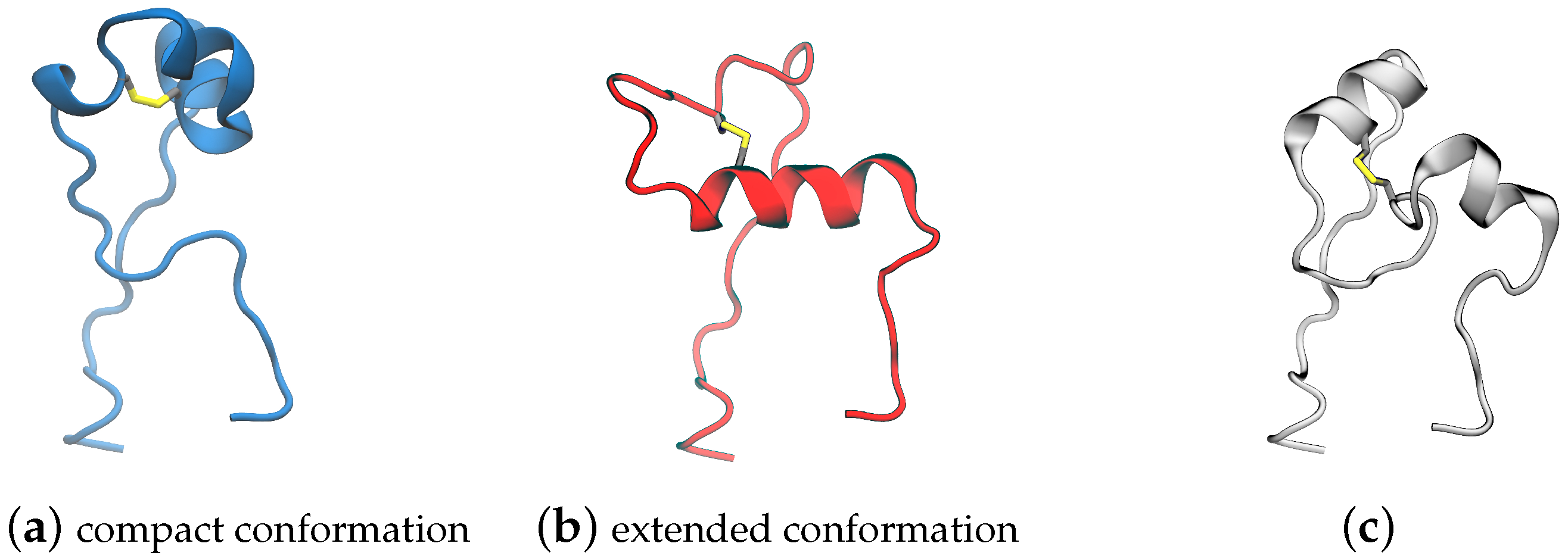
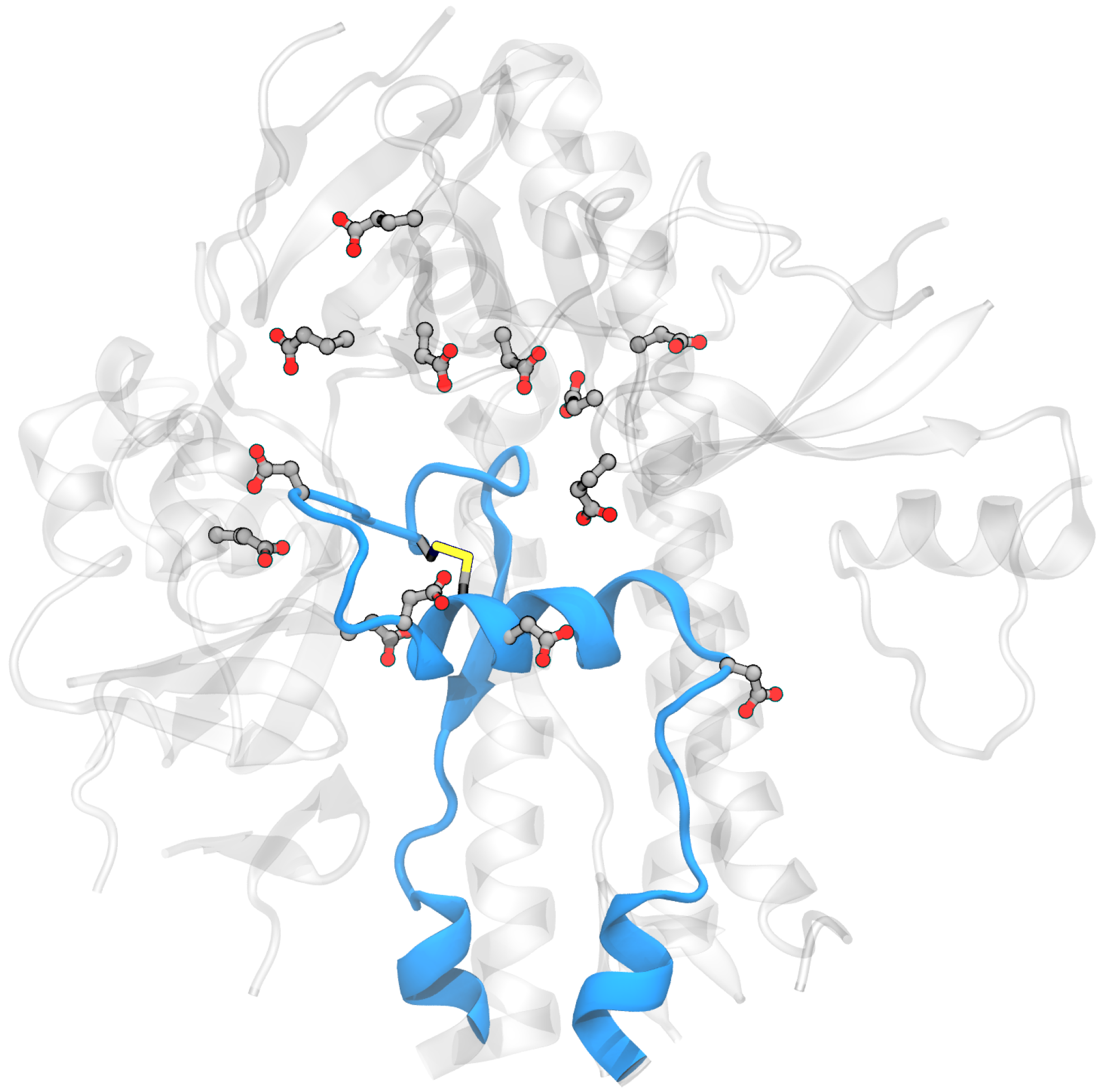

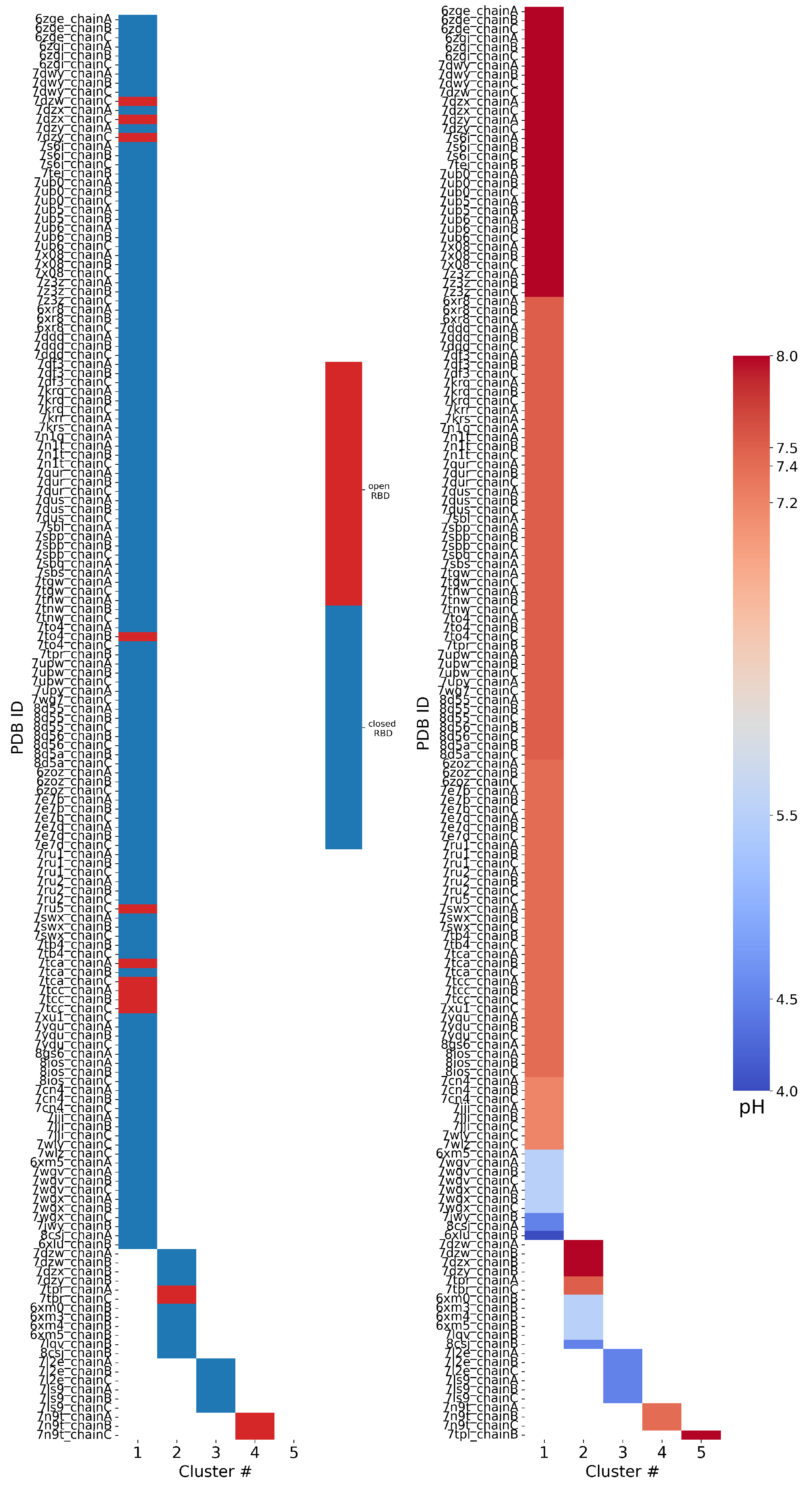
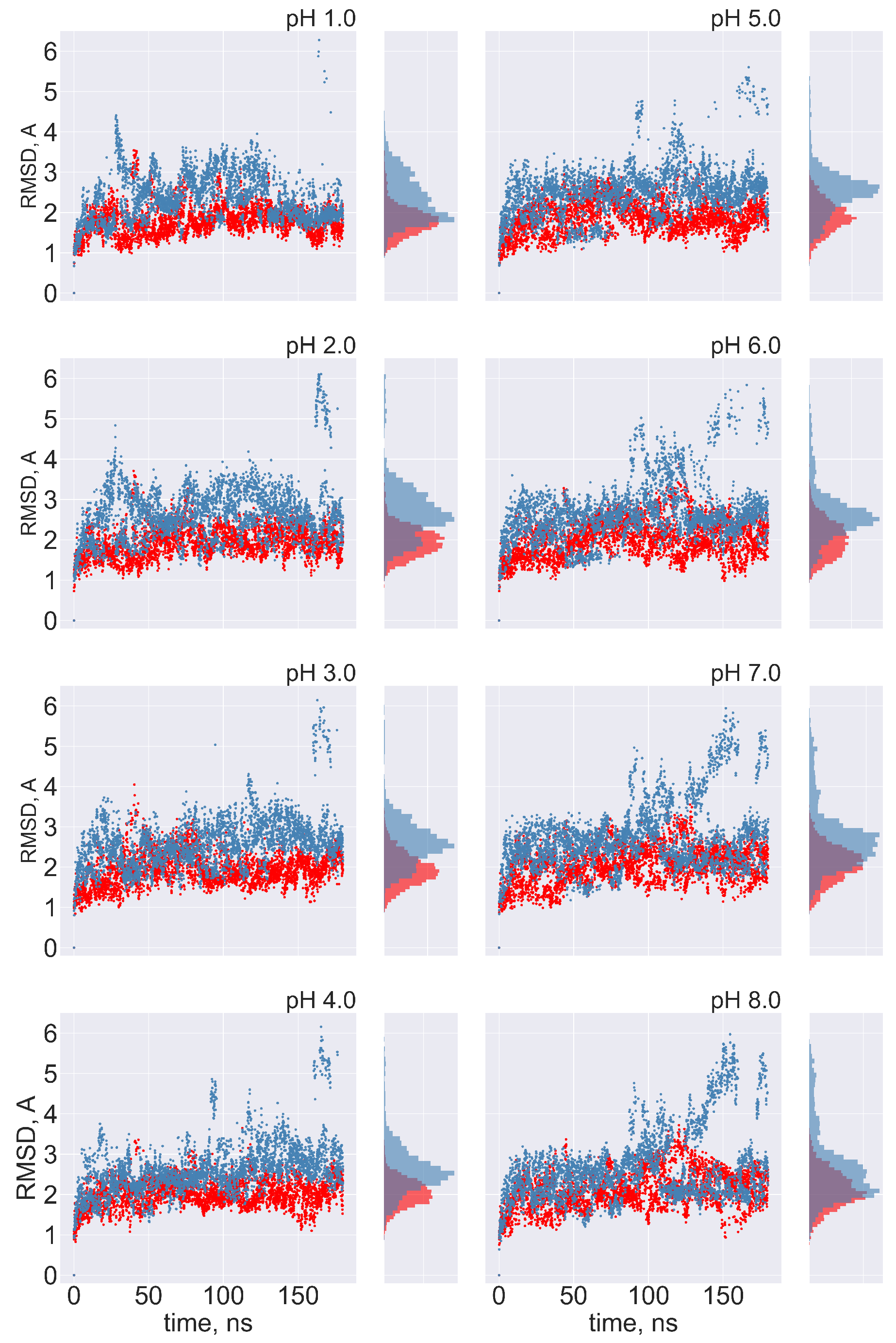
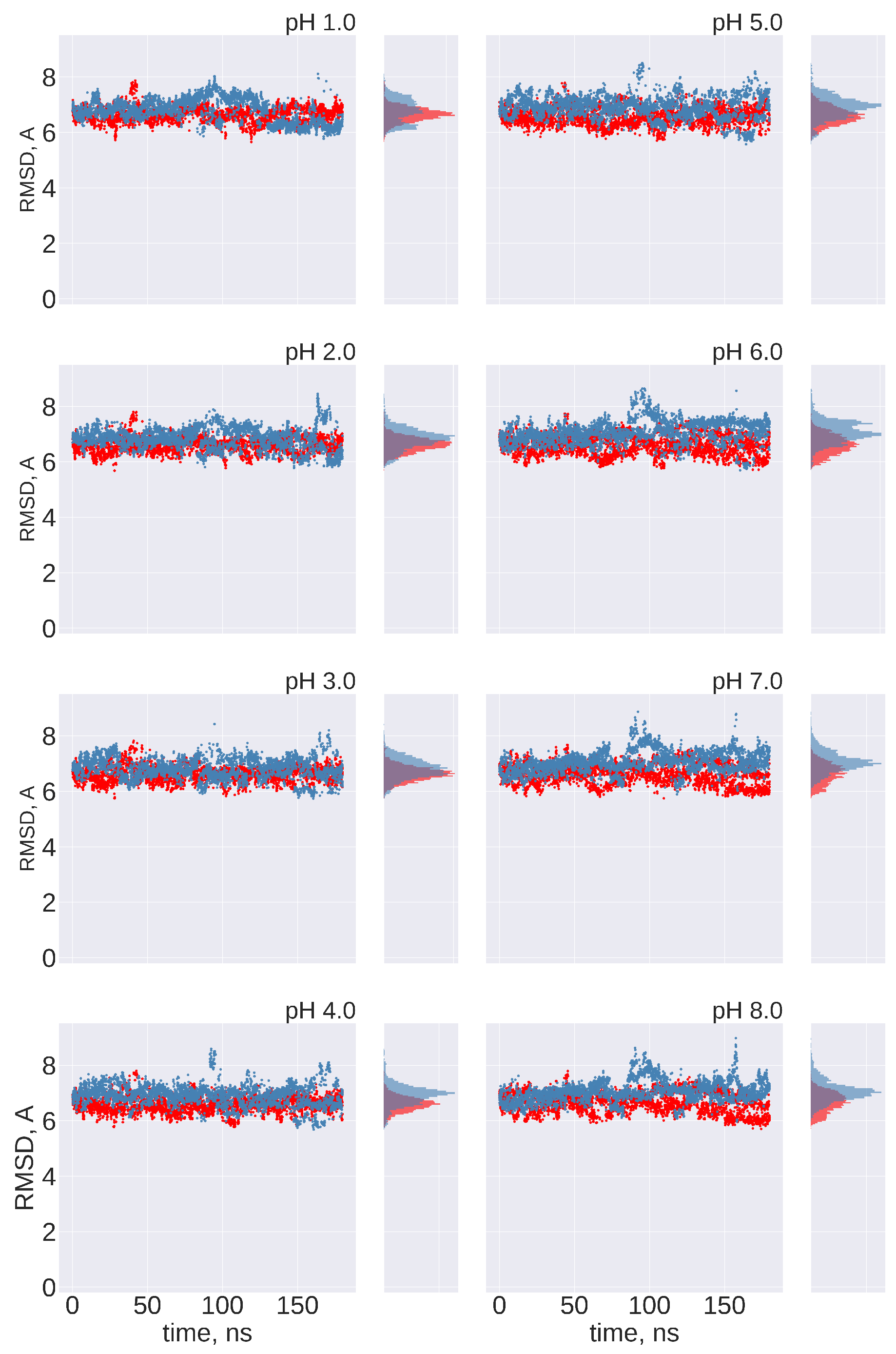
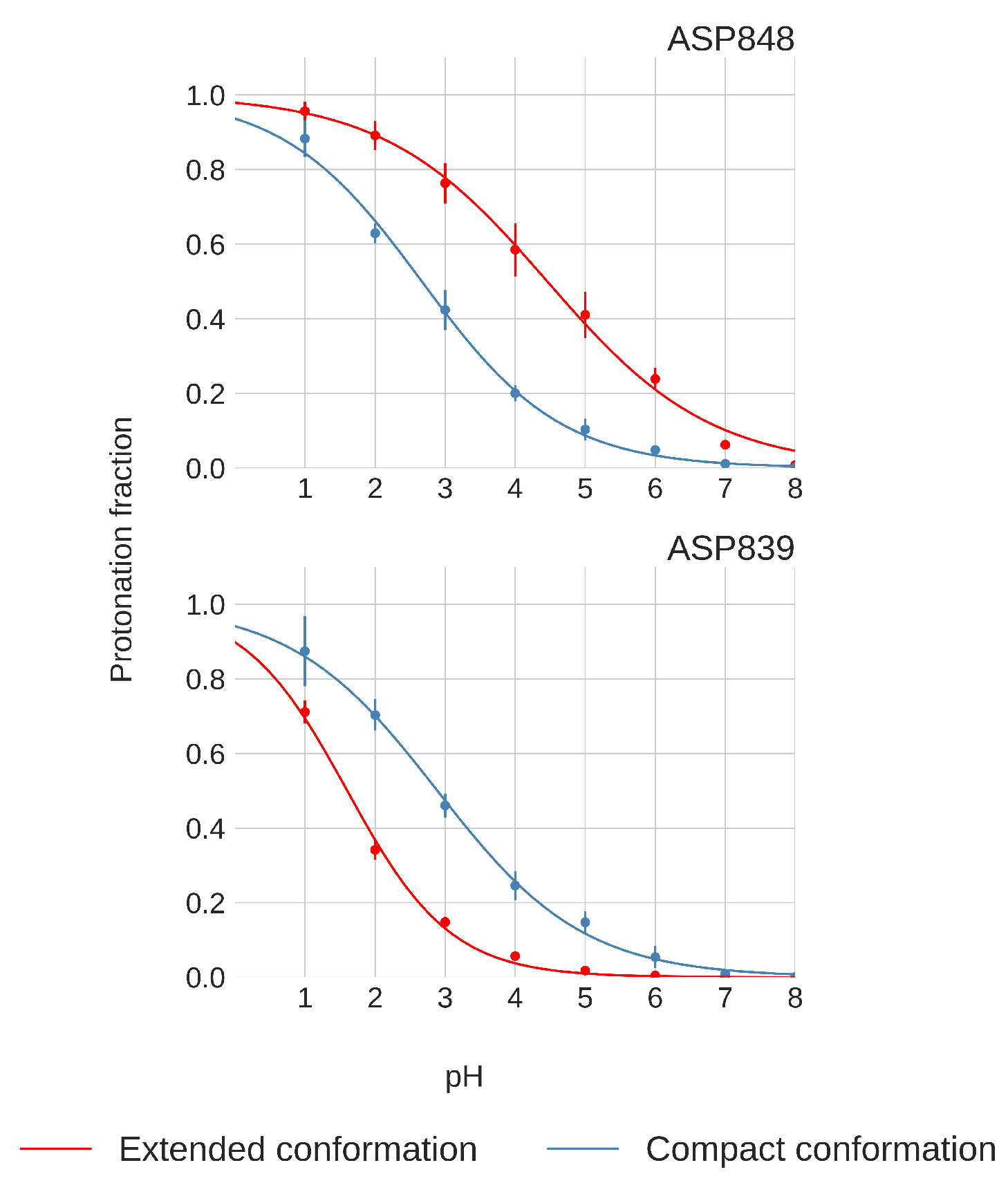
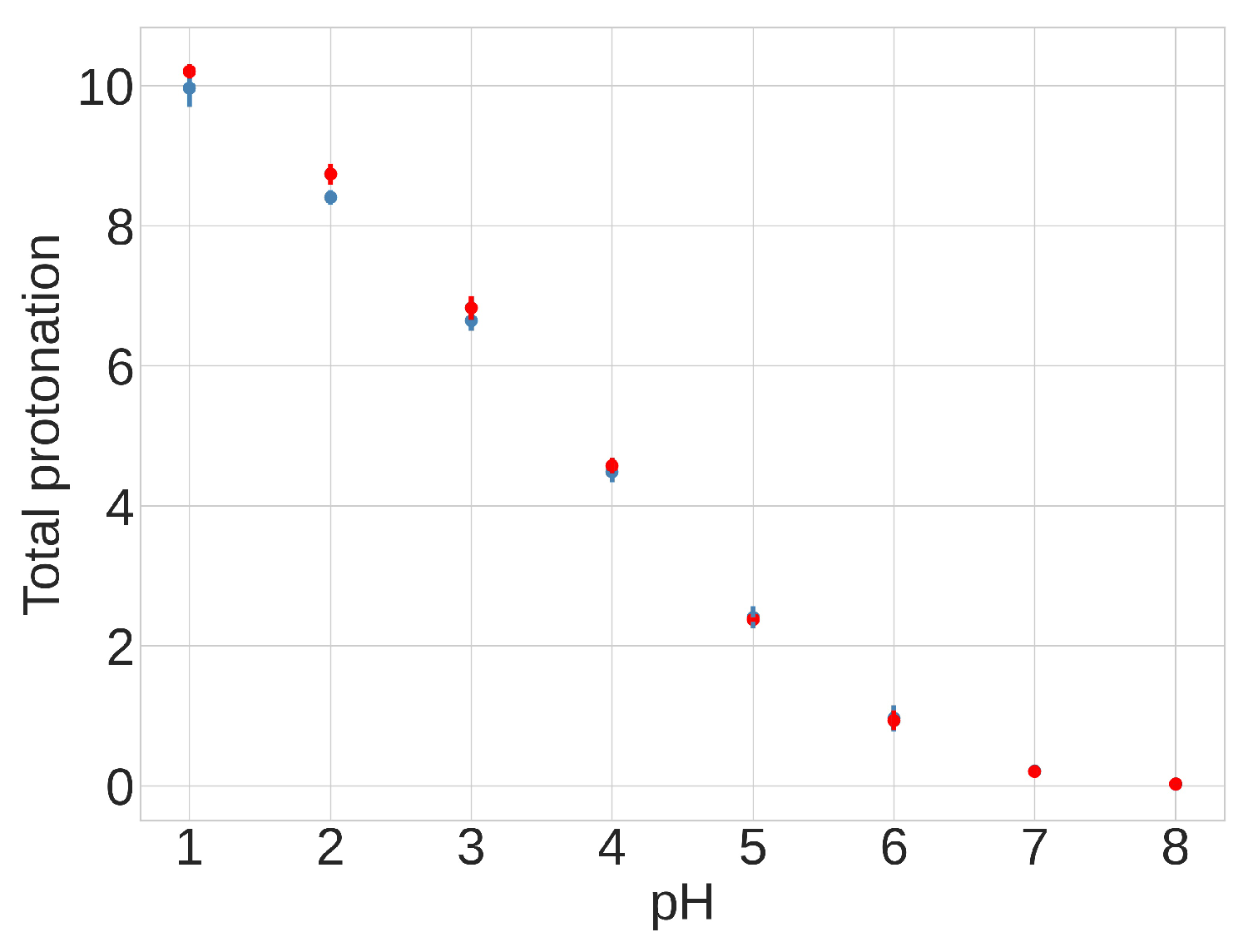
| Cluster | Structures # | AvgDist | AvgCDist |
|---|---|---|---|
| 1 | 136 | 1.9 | 9.4 |
| 2 | 12 | 1.7 | 8.0 |
| 3 | 6 | 0.6 | 8.2 |
| 4 | 3 | 0.0 | 10.2 |
| 5 | 1 | 0.0 | 9.8 |
| Extended Conformation | Compact Conformation | ||||
|---|---|---|---|---|---|
| Residue | FPPR Chain | 6XM0 | 7LQV | 6XLU | 7WGX |
| Glu 281 | B | 3.6 | 4.0 | 4.1 | 4.0 |
| Glu 554 | A | 4.2 | 3.9 | 4.6 | 3.9 |
| Asp 568 | A | 4.7 | 4.9 | 6.1 | 5.9 |
| Asp 571 | A | 4.3 | 4.9 | 4.8 | 5.1 |
| Asp 574 | A | 6.0 | 6.9 | 5.4 | 5.5 |
| Glu 583 | A | 4.9 | 5.3 | 4.9 | 3.4 |
| Asp 586 | A | 4.7 | 5.0 | 5.0 | 4.9 |
| Asp 614 | A | 5.5 | 5.8 | 7.2 | 4.9 |
| Glu 619 | A | 4.9 | 4.9 | 4.2 | 3.6 |
| Asp 830 | B | 4.2 | 4.6 | 4.5 | 4.1 |
| Asp 839 | B | 3.9 | 3.8 | 3.6 | 4.5 |
| Asp 843 | B | 4.2 | 4.3 | 6.0 | 3.8 |
| Asp 848 | B | 4.4 | 4.5 | 4.9 | 3.8 |
| Extended | Compact | ||
|---|---|---|---|
| Residue | Chain | pKa | pKa |
| Glu 281 | B | 3.8 ± 0.0 | 3.7 ± 0.3 |
| Glu 554 | A | 3.0 ± 0.1 | 2.8 ± 0.1 |
| Asp 568 | A | 1.4 ± 0.1 | 1.1 ± 0.3 |
| Asp 571 | A | 3.2 ± 0.0 | 3.8 ± 0.2 |
| Asp 574 | A | negative | negative |
| Glu 583 | A | 3.6 ± 0.0 | 3.2 ± 0.1 |
| Asp 586 | A | negative | negative |
| Asp 614 | A | 3.8 ± 0.2 | 3.7 ± 0.4 |
| Glu 619 | A | 4.7 ± 0.0 | 4.5 ± 0.1 |
| Asp 830 | B | 4.9 ± 0.1 | 5.4 ± 0.5 |
| Asp 839 | B | 1.6 ± 0.1 | 2.9 ± 0.2 |
| Asp 843 | B | 4.4 ± 0.3 | 4.3 ± 0.5 |
| Asp 848 | B | 4.5 ± 0.2 | 2.7 ± 0.1 |
| pH | Fraction of Compact | Fraction of Extended |
|---|---|---|
| 1 | 0.31 ± 0.09 | 0.69 ± 0.09 |
| 2 | 0.53 ± 0.04 | 0.47 ± 0.04 |
| 3 | 0.63 ± 0.04 | 0.37 ± 0.04 |
| 4 | 0.52 ± 0.09 | 0.48 ± 0.09 |
| 5 | 0.42 ± 0.13 | 0.58 ± 0.13 |
| 6 | 0.44 ± 0.06 | 0.56 ± 0.06 |
| 7 | 0.56 ± 0.15 | 0.44 ± 0.15 |
| 8 | 0.60 ± 0.19 | 0.40 ± 0.19 |
Disclaimer/Publisher’s Note: The statements, opinions and data contained in all publications are solely those of the individual author(s) and contributor(s) and not of MDPI and/or the editor(s). MDPI and/or the editor(s) disclaim responsibility for any injury to people or property resulting from any ideas, methods, instructions or products referred to in the content. |
© 2024 by the authors. Licensee MDPI, Basel, Switzerland. This article is an open access article distributed under the terms and conditions of the Creative Commons Attribution (CC BY) license (https://creativecommons.org/licenses/by/4.0/).
Share and Cite
Stepanenko, D.; Wang, Y.; Simmerling, C. Assessing pH-Dependent Conformational Changes in the Fusion Peptide Proximal Region of the SARS-CoV-2 Spike Glycoprotein. Viruses 2024, 16, 1066. https://doi.org/10.3390/v16071066
Stepanenko D, Wang Y, Simmerling C. Assessing pH-Dependent Conformational Changes in the Fusion Peptide Proximal Region of the SARS-CoV-2 Spike Glycoprotein. Viruses. 2024; 16(7):1066. https://doi.org/10.3390/v16071066
Chicago/Turabian StyleStepanenko, Darya, Yuzhang Wang, and Carlos Simmerling. 2024. "Assessing pH-Dependent Conformational Changes in the Fusion Peptide Proximal Region of the SARS-CoV-2 Spike Glycoprotein" Viruses 16, no. 7: 1066. https://doi.org/10.3390/v16071066
APA StyleStepanenko, D., Wang, Y., & Simmerling, C. (2024). Assessing pH-Dependent Conformational Changes in the Fusion Peptide Proximal Region of the SARS-CoV-2 Spike Glycoprotein. Viruses, 16(7), 1066. https://doi.org/10.3390/v16071066





